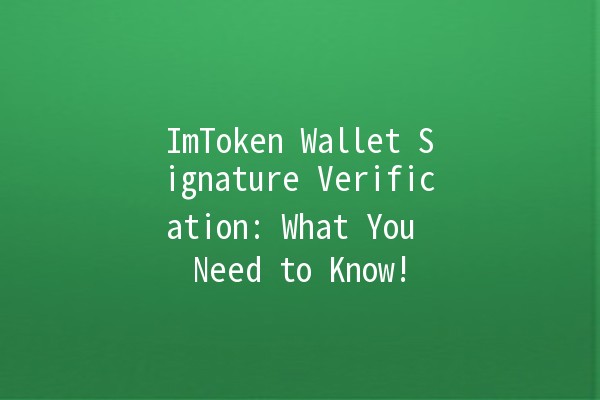In the world of cryptocurrency, security is of paramount importance, and one essential aspect of security is the ability to verify the authenticity of transactions. ImToken, a popular Ethereum wallet, provides users with features that enhance security, including signature verification. This article delves into the significance of signature verification in ImToken, provides practical tips for users, and highlights some productivityenhancing techniques related to managing crypto assets.
Signature verification is a cryptographic method used to ensure that a digital message or document is authentic and has not been altered. In the context of cryptocurrency wallets like ImToken, this process is crucial. When a user initiates a transaction, their wallet generates a signature using their private key. This signature is then sent along with the transaction data. Receivers can verify this signature using the sender's public key, confirming the integrity and authenticity of the transaction.

Description: Adding an extra layer of security by enabling 2FA means that even if someone obtains your password, they would still need a second form of identification to access your wallet.
Application Example: Use apps like Google Authenticator or Authy to set up 2FA, which requires a timebased onetime password in addition to your usual login credentials.
Description: Having a backup of your wallet can save you from a potential loss of funds in case your device becomes inaccessible.
Application Example: ImToken allows users to export their private keys or seed phrase. Ensure to store these securely, perhaps in a physical location away from your electronic devices.
Description: Regular updates often come with security patches and improvements that can protect your assets better.
Application Example: Monitor the ImToken app for updates and install them promptly to enhance security measures.
Description: Leverage builtin features of ImToken to organize and categorize your transactions effectively.
Application Example: Regularly reviewing your transaction history assists in tracking your spending and ensures your signature verification remains accurate.
Description: Understanding how signatures work and their cryptographic underpinnings can make you a more informed user.
Application Example: Reading documentation from ImToken and other crypto resources can provide deeper insights into signature algorithms and enhance your ability to confidently verify transactions.
In ImToken, when a transaction is created, a digital signature is generated using the sender’s private key. This signature, along with the transaction details, is sent to the network. The recipient or network nodes can verify the signature using the sender's public key, ensuring the transaction's authenticity.
If your signature verification fails, it might indicate an issue with your private key, your transaction data, or that the transaction has been tampered with. Check that you're using the correct keys and data. If issues continue, consult ImToken support.
Yes! You can use various tools and libraries like web3.js for Ethereum which provides methods to manually verify signatures. This involves understanding the underlying cryptographic functions.
Not verifying signatures could lead to unauthorized transactions and loss of funds. It is critical to always check signatures before confirming any transaction.
Use strong, unique passwords, enable twofactor authentication, and always keep your software up to date. Being aware of phishing attempts and ensuring you only download from official sources is also crucial.
While ImToken offers secure storage for private keys, it’s best to understand the risks. For complete security, consider keeping a physical copy of your private keys and avoid storing them on internetconnected devices.
Understanding the functionality of signature verification can greatly benefit users in their daytoday management of cryptocurrencies. Below are a couple of scenarios that illustrate its significance:
Transaction Authorization: Whenever you transfer or receive funds, signature verification ensures that both parties’ wallets have executed transactions that reflect their true intentions. For example, if Alice sends 1 ETH to Bob, the transaction is signed by Alice’s private key. Bob uses her public key to confirm the authenticity of the transaction.
Smart Contracts Activation: In more complex scenarios such as smart contracts, signature verification plays a pivotal role in executing predefined actions based on specific conditions. If certain criteria are met, signatures authorize the release of funds or trigger actions in the contract, ensuring everything operates as agreed upon.
In the cryptocurrency domain, understanding and correctly implementing signature verification can dramatically enhance your security and transaction authenticity. As you navigate through platforms such as ImToken, utilizing the outlined productivity tips will help optimize your experience and secure your assets. By taking the time to educate yourself and implement best practices, you contribute to a safer and more trustworthy crypto ecosystem.